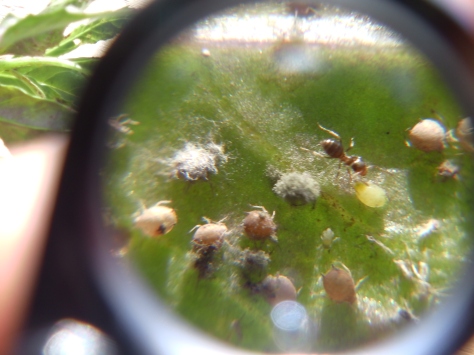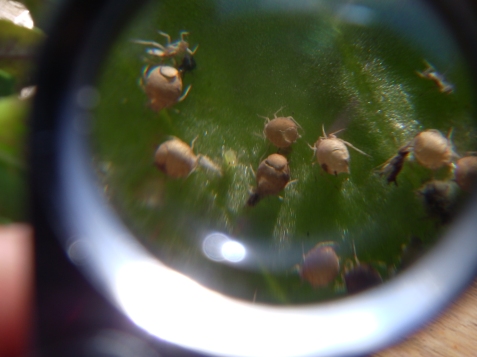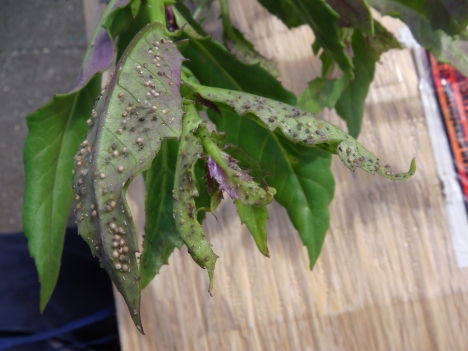I was lucky enough to go out in my garden this morning and capture this amazing picture. The untrained eye may not realize it, but there is a LOT going on here, and it is an excellent demonstration of beneficial/predatory pest relationships.  If you look closely you will see aphids in three different forms here. The first aphid (small translucent green) is a living and thriving aphid who is being farmed by an ant. Aphids eat plant sugars by penetrating the protective surface of the plant and releasing the food. The ant, that you see, has a mutually beneficial relationship with the aphid. The ants corral the aphids, try to protect them from predators, and even bring their eggs down into their mounts to protect them during the cold season, bringing them back up when the weather is again suitable. In return for their labor, the ants get the pleasure of “milking” the aphids. They jostle the little creatures while they are sucking the plant sugars and cause them to spill their spoils. The ants then harvest the plant sugars for themselves and their friends.
If you look closely you will see aphids in three different forms here. The first aphid (small translucent green) is a living and thriving aphid who is being farmed by an ant. Aphids eat plant sugars by penetrating the protective surface of the plant and releasing the food. The ant, that you see, has a mutually beneficial relationship with the aphid. The ants corral the aphids, try to protect them from predators, and even bring their eggs down into their mounts to protect them during the cold season, bringing them back up when the weather is again suitable. In return for their labor, the ants get the pleasure of “milking” the aphids. They jostle the little creatures while they are sucking the plant sugars and cause them to spill their spoils. The ants then harvest the plant sugars for themselves and their friends.
 The third aphid you see, in the first picture, is covered in a blueish green fuzz. This is a beneficial (to us), parasitic fungus which infects and feeds on living aphids As you can see, from this broader picture, the plant (Okinawa spinach) was covered in aphids, but upon closer examination it can be seen that over 90% of them are parasitized or killed by beneficial fungus.
The third aphid you see, in the first picture, is covered in a blueish green fuzz. This is a beneficial (to us), parasitic fungus which infects and feeds on living aphids As you can see, from this broader picture, the plant (Okinawa spinach) was covered in aphids, but upon closer examination it can be seen that over 90% of them are parasitized or killed by beneficial fungus.  Sometimes, when I have harmful insect infestations, I use organic sprays or manual labor to remove the pest, but it is important to only do this when it is necessary for the life of the plant. The reason for this is because predatory/beneficial insects need these pests to maintain their populations in your ecosystem. This is just one small example of how allowing natural ecosystems to evolve and develop in our food producing ecosystems can solve many of our problems.
Sometimes, when I have harmful insect infestations, I use organic sprays or manual labor to remove the pest, but it is important to only do this when it is necessary for the life of the plant. The reason for this is because predatory/beneficial insects need these pests to maintain their populations in your ecosystem. This is just one small example of how allowing natural ecosystems to evolve and develop in our food producing ecosystems can solve many of our problems.